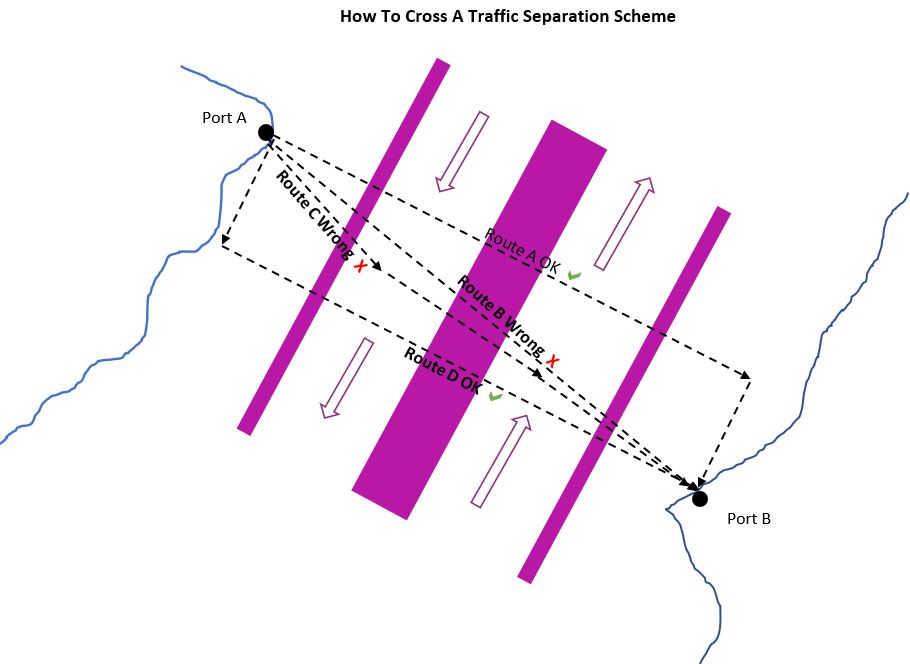Rule 10 Traffic Separation Schemes Explained
This is one of the longest rules, always remember the following:
All of the other rules continue to apply within a traffic separation scheme.
There is no right of way – a traffic separation lane does not give you right of way over any other vessels.
The actions of vessels navigating in and near a traffic separation scheme can be unpredictable.
Traffic separation schemes are established in busy areas of difficult navigation.
You can expect above-average density of traffic, crossing vessels, fishing vessels and high-speed craft. Study the passage before your watch, be prepared and, if you need assistance, ask for it well in advance.
Tips for navigating in traffic separation schemes are:
Always follow all the other rules.
Keep in your lane.
Particular caution is required at the ends of the scheme.
Avoid VHF calls to other ships – it will only distract them.
Beware of fishing vessels – they are allowed to fish in traffic separation lanes.
Look out for crossing vessels – they should cross the scheme at right angles but they may navigate parallel to the scheme for a while to find an opportunity to cross.
Look out for high-speed craft – especially wide on your beam.
If you are not happy, slow down or stop.
Be wary at all times.
RULE 10
(a) This Rule applies to traffic separation schemes adopted by the Organisation and does not relieve any vessel of her obligation under any other Rule.
(b) A vessel using a traffic separation scheme shall:
(i) proceed in the appropriate traffic lane in the general direction of traffic flow for that lane;
(ii) so far as practicable keep clear of a traffic separation line or separation zone;
(iii) normally join or leave a traffic lane at the termination of the lane, but when joining or leaving from either side shall do so at as small an angle to the general direction of traffic flow as practicable.
(c) A vessel shall, so far as practicable, avoid crossing traffic lanes but if obliged to do so shall cross on a heading as nearly as practicable at right angles to the general direction of traffic flow.
(d) (i) A vessel shall not use an inshore traffic zone when she can safely use the appropriate traffic lane within the adjacent traffic separation scheme.
However, vessels of less than 20 metres in length, sailing vessels and vessels engaged in fishing may use the inshore traffic zone.
(ii) Notwithstanding sub-paragraph (d) (i), a vessel may use an inshore traffic zone when en route to or from a port, offshore installation or structure,pilot station or any other place situated within the inshore traffic zone, or to avoid immediate danger.
(e) A vessel other than a crossing vessel or a vessel joining or leaving a lane shall not normally enter a separation zone or cross a separation line except:
(i) in cases of emergency to avoid immediate danger;
(ii) to engage in fishing within a separation zone.
(f) A vessel navigating in areas near the terminations of traffic separation schemes shall do so with particular caution.
(g) A vessel shall so far as practicable avoid anchoring in a traffic separation scheme or in areas near its terminations.
(h) A vessel not using a traffic separation scheme shall avoid it by as wide a margin as is practicable.
(i) A vessel engaged in fishing shall not impede the passage of any vessel following a traffic lane.
(j) A vessel of less than 20 metres in length or a sailing vessel shall not impede the safe passage of a power-driven vessel following a traffic lane.
(k) A vessel restricted in her ability to manoeuvre when engaged in an operation for the maintenance of safety of navigation in a traffic separation scheme is exempted from complying with this Rule to the extent necessary to carry out the operation.
(l) A vessel restricted in her ability to manoeuvre when engaged in an operation for the laying, servicing or picking up of a submarine cable, within a traffic separation scheme, is exempted from complying with this Rule to the extent necessary to carry out the operation.
